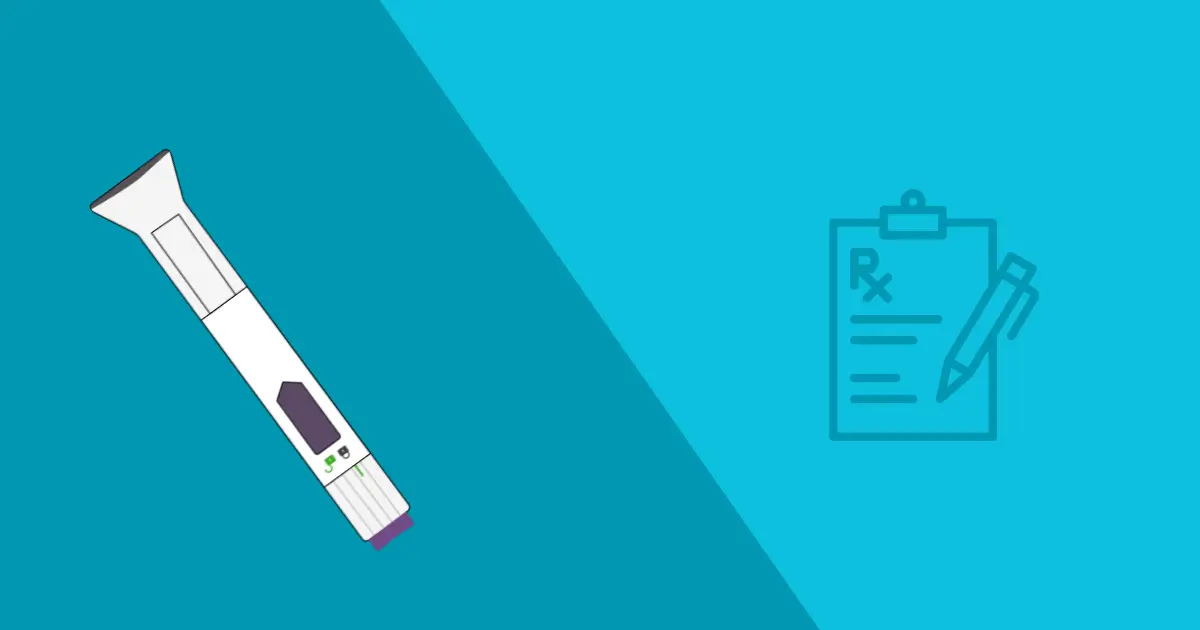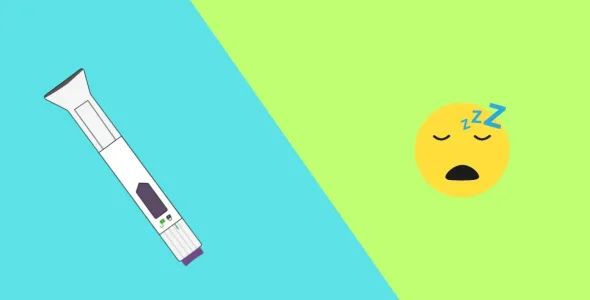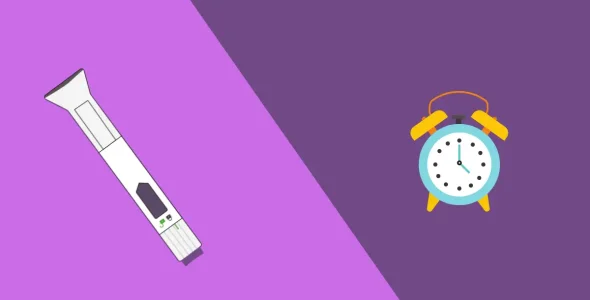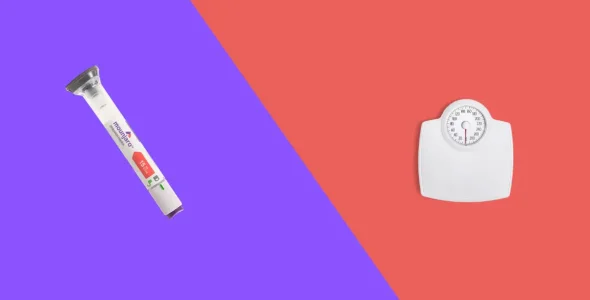Mounjaro dosage chart: The complete guide for diabetes and weight loss (off-label)
The standard Mounjaro dosage starts at 2.5 mg once weekly, increasing gradually every 4 weeks to 5 mg, 7.5 mg, 10 mg, 12.5 mg, or 15 mg based on tolerance and medical needs. Getting the right Mounjaro dosage is key to maximizing benefits while minimizing side effects—here’s what you need to know.
Key highlights
- Mounajro is a brand-name medication containing tirzepatide, which acts as a dual agonist at GLP-1 and GIP receptors. The medication is FDA-approved for blood sugar control in adults with type 2 diabetes.
Manufactured by Eli Lilly, Mounjaro (tirzepatide) is an FDA-approved once-weekly injectable medication for managing blood sugar in adults with type 2 diabetes. Healthcare professionals also commonly prescribe the medication off-label for weight loss in obese and overweight individuals. Mounjaro has a dual mechanism of action; the medication activates GLP-1 (glucagon-like peptide-1) and GIP (glucose-dependent insulinotropic polypeptide) receptors simultaneously. Mounjaro is more effective than other GLP-1 receptors in promoting blood sugar control due to its dual agonism. In clinical trials, Mounjaro reduced HbA1c levels by 2.01%, 2.24%, and 2.30% with 5 mg, 10 mg, and 15 mg weekly doses of Mounjaro, compared to 1.86% with semaglutide after 40 weeks.
Like other diabetes medications, you need to follow a standard dosing schedule for Mounjaro to achieve optimal glycemic control in type 2 diabetes management. It is important to strictly follow the dosing schedule prescribed by your healthcare professional to get the desired results and minimize the risk of side effects.
This article provides a comprehensive and easy-to-understand guide to Mounjaro dosage and covers the starting dose, titration schedule, maintenance doses, maximum dose, administration, and other important considerations.
Official Mounjaro dosage guidelines (FDA-approved protocol)
According to FDA-approved protocol, Mounjaro is started at a very low dose, and the dosage is escalated gradually every 4 weeks (if needed), according to the patient’s response and tolerance.
Starting dose (weeks 1-4)
The initial dose of Mounjaro is 2.5 mg once weekly for the first 4 weeks. The medication is started at a low dose to help the body adjust to the medication and minimize potential gastrointestinal side effects such as nausea, vomiting, diarrhea, stomach pain, and constipation.
Dose titration (gradually increasing the dose every 4 weeks)
During the titration phase, your doctor adjusts the dosage every 4 weeks. If you can tolerate the existing dosage, they will increase the dosage by 2.5 mg increments. They will continue increasing the dosage until you achieve the target glycemic control.
- Weeks 5-8: 5 mg once weekly.
- Weeks 9-12: 7.5 mg once weekly (if your body can tolerate the previous dosage and further glycemic control is needed).
- Weeks 13-16: 10 mg once weekly (if further blood sugar control is needed).
- Weeks 17-20: 12.5 mg once weekly (if you have not achieved optimal glycemic control with the previous dose).
- Week 21 onwards (maximum maintenance dose): 15 mg once weekly (if needed).
The dosage of Mounjaro is increased gradually to give your body enough time to adjust to the medication and avoid unwanted side effects associated with higher doses. This gradual increase allows for individualized treatment based on blood sugar response and tolerability. However, it is not recommended to increase the dose more frequently than every 4 weeks.
If your body does not tolerate the medication, your healthcare provider will reduce the dosage or delay dose escalation for the next 4 weeks. After 4 weeks, they will reassess your condition and adjust the dosage accordingly.
Maintenance dose
Mounjaro does not have a single maintenance dose. The effective maintenance dose varies between individuals (5 mg, 7.5 mg, 10 mg, 12.5 mg, or 15 mg once weekly) after the initial 4 weeks.
Your doctor will adjust your dose based on your blood sugar levels and how well your body tolerates the medication. A few patients need lower doses to achieve blood sugar control, while others need higher doses.
Maximum dose
According to the U.S. Food and Drug Administration (FDA), 15mg once weekly is the maximum dose of Mounjaro.
| Available strengths | 2.5 mg, 5 mg, 7.5 mg, 10 mg, 12.5 mg, 15 mg |
| Dosing frequency | Once weekly |
| Method of administration | Subcutaneous (in the abdomen, upper thigh, and arms) |
| Starting dose | Weeks 1–4: 2.5 mg once a week |
| Titration schedule | Weeks 5–8: 5 mg once weekly Weeks 9–12: 7.5 mg once weekly Weeks 13–16: 10 mg once weekly Weeks 17–20: 12.5 mg once weekly Week 20 and onwards: 15 mg once weekly |
| Maintenance dose | 5 mg, 10 mg, 12.5 mg, or 15 mg once a week |
| Maximum dose | 15 mg once a week |
| What to do when you miss a dose | If more than 4 days (96 hours) have passed since the missed dose, skip the missed dose and take the next dose on the regularly scheduled day. If less than 4 days have passed, take the missed dose as soon as possible and then take the next dose on the regularly scheduled day. If you have missed doses for over 2 weeks, consult your healthcare provider, as they may prescribe a lower dosage. |
| Do's | - Store the medication in its original packaging between 36–46°F (2°C to 8°C), away from light. This helps maintain its potency. - If traveling, keep the medication unrefrigerated for no more than 21 days. Ensure it stays below 86°F (30°C). - If less than 4 days have passed since a missed dose, take it as soon as possible and return to your regular dosing schedule. - Keep a record of your weekly doses to avoid skipping or duplicating doses. - Take regular follow-ups with your healthcare provider to ensure the medication is working effectively and adjust the dosage if necessary. |
| Don’ts | - Do not store the pen in the refrigerator for extended periods or freeze it, as it could damage the medication. - Do not use the pen if it has been dropped or exposed to hard impacts (e.g., hitting a hard surface), as it may not work properly. - Do not exceed the recommended dosage or inject double doses. - Do not use the pen if it appears damaged or compromised in any way or the medications looks cloudy. - Do not expose the pen to extreme temperatures (over 86°F or 30°C) or direct sunlight. |
Mounjaro dosage for weight loss (off-label)
Mounjaro is FDA-approved for type 2 diabetes. The medication is also used off-label for weight management in obese (BMI 30 or greater ) and overweight (BMI 27 or greater) individuals.
The same active ingredient, tirzepatide, is approved by the FDA under the brand name Zepbound specifically for chronic weight management and to manage weight-related complications such as moderate to severe obstructive sleep apnea (OSA). If you want to use tirzepatide solely for weight loss, Zepbound is a better option as the medication is FDA-approved for this purpose.
This article focuses on Mounjaro dosage for type 2 diabetes management.
The typical maintenance dose of Mounjaro for weight loss (when your doctor prescribes it off-label) ranges between 5 mg and 15 mg.
Mounjaro dosage for weight loss vs. diabetes
Most diabetic patients achieve glycemic control at a 5 mg to 10 mg weekly dose of Mounjaro. Some patients may need a 12.5 mg or 15 mg once weekly dose of Mounjaro to obtain target glycemic control.
When used off-label for weight management, patients usually need a 10 mg to 15 mg weekly injection of Mounjaro for significant weight reduction.
However, Zepbound is a preferred medication if you want to lose weight with tirzepatide, as the medication is FDA-approved for this purpose.
In a clinical trial, 2,539 patients with obesity (BMI 30 or more) and overweight (BMI 27 or more) were randomly assigned to receive 5 mg, 10 mg, 15 mg of tirzepatide and placebo. After 72 weeks, patients lost 19% of body weight with a 5 mg weekly dose of tirzepatide, 19.5% with a 10 mg dose, and 20.9% with a 15 mg weekly injection of tirzepatide. The placebo showed only 3.1% weight loss.
These results reflect that higher doses of tirzepatide (Mounjaro) are more effective for weight management compared to low doses.
How to adjust your Mounjaro dose
Never try to adjust or change your dosing schedule without consulting your healthcare professional. Healthcare providers create a personalized titration schedule for each patient and adjust it according to the patient’s blood sugar levels and needs. You cannot follow the same titration schedule prescribed for someone else.
When to decrease
If you experience intolerable side effects, your doctor may delay dose escalation or temporarily reduce your dosage to give your body enough time to adjust. This is why it is important to keep track of all body changes and discuss them with your doctor to minimize the risk of severe side effects.
When to increase
If blood sugar levels of glycated hemoglobin (A1C) levels remain high despite taking the medication, your doctor will increase the dosage of Mounjaro
If you are using Mounjaro off-label for weight management and you have reached a weight loss plateau, your doctor will increase the dosage.
When to stay on the current dose
If you experience mild side effects such as nausea, vomiting, diarrhea, or constipation, your healthcare provider will most likely keep you on the same dosage. These side effects usually subside over time.
Additionally, if you have achieved adequate blood sugar control/glycemic control at lower doses, they will not escalate the dosage.
Never self-adjust the dosage
Always consult your doctor before adjusting your dosage, as dosage escalation needs medical supervision to lower the risk of severe side effects.
What to do if you miss a dose
If you miss a dose and it is within 4 days (96 hours) of your usual injection day
Inject the missed dose as early as possible when you remember. Afterwards, take your next dose on your regularly scheduled day.
If you miss a dose and it is more than 4 days (96 hours) past your usual injection day
Do not administer the missed dose. Wait until your next regularly scheduled dose and take your next dosage according to your schedule.
For example, if you inject Mounjaro on Monday each week, and you forgot to take your medication on Monday. If you remember it any day before Thursday, you can take the medication. If you remember on Friday or any day after Friday, skip the dose and take the next one on Monday. Do not take two doses within 4 days of each other.
Never double dose
Never inject double doses of the medication, as it can increase the risk of severe side effects.
How to inject Mounjaro
Mounjaro comes in two forms: pre-filled injections and vials. Both of them contain fixed and single doses of the medication. The medication is injected subcutaneously (under the skin, just above your muscles). Mounjaro pens and vials are available in strengths of 2,5 mg, 5 mg, 7.5 mg, 10 mg, 12.5 mg, and 15 mg.
Follow these steps to inject Mounjaro safely:
Before you begin
- Take the Mounjaro pen or vial out of the refrigerator when you are ready to inject.
- Keep the gray base cap on until just before the injection to protect the needle.
- Check the label of the pen or vial to make sure you have the correct dose and that the medication has not expired.
- Hold the pen or vial up to the light and check the liquid. Normally, Mounjaro is clear to slightly yellow, with no particles or cloudiness. If you see particles or the pen/vial is damaged, do not use the medication and contact your supplier.
- If you see any air bubbles in the liquid, there is no need to worry. It is completely normal and does not affect the dose.
- Wash your hands thoroughly with soap and water to lower the risk of skin infections.
Step 1: Choose your injection site
- You can inject Mounjaro into the stomach (at least 2 inches away from the belly button) or the front of the thigh.
- If someone else is assisting you in administering the injection, you can get it injected into the back of your upper arm.
- Each time, use a different spot to prevent skin irritation and the formation of lumps and scarring.
- Do not inject into areas that are bruised, thickened, tender, hard, or scarred.
Step 2: Remove the gray base cap
- Make sure the pen is still locked before removing the cap.
- Hold the pen firmly and pull the gray base cap straight off. Do not twist it.
- Do not put the cap back on, as this can damage the needle.
- Avoid touching the needle after the cap is removed to prevent contamination.
- If you see a small drop of liquid on the needle tip, there is no need to worry, as this is normal.
- If you are using the Mounjaro vial, remove its cap. Fill a small amount of air in the syringe and insert a needle into the vial.
- Hold the vial upside down to fill the injection. Once filled, remove the injection from the vial.
- Press the plunger and remove all air bubbles from the syringe.
Step 3: Place the pen on your skin and unlock it
- Firmly press the clear base of the pen flat against your chosen injection site.
- While holding the pen in place, turn the lock ring to unlock the pen.
- Your hand should be steady, and the pen should remain in full contact with your skin.
Step 4: Start the injection
- Press the purple injection button and hold the pen firmly against your skin for up to 10 seconds.
- You will hear the first click when the injection begins and a second click when the dose has been delivered.
- You may hear an extra soft click in between. That is also completely normal and part of the pen’s function.
- Once the second click sound is heard, look at the pen window. If the gray plunger is visible, it means your full dose has been delivered.
- If the plunger is not visible, contact the manufacturer before attempting to administer the next dose.
- After injecting, you might notice a small drop of blood or liquid at the injection site. This is normal. Gently press a cotton ball or gauze on the area, but do not rub
Step 5: Dispose of the used pen safely
- After injecting, immediately throw the used Mounjaro pen in a proper sharps disposal container.
- Do not throw the pen in the regular trash.
- If you don’t have a sharps container, use a heavy-duty plastic container (like an empty detergent bottle) with a tight-fitting lid.
- Label the container to indicate that it holds hazardous sharps waste.
- Follow local regulations for proper sharps disposal.
- Do not recycle your sharps container.
How to store Mounjaro
- Store Mounjaro pens in the refrigerator between 36°F and 46°F (2°C to 8°C).
- You may store the pen at room temperature (up to 86°F or 30°C) for up to 21 days.
- Do not freeze the pen. If it accidentally freezes, throw it away and use a new one.
- Keep the pen in its original carton/packing to protect it from light.
- Always store Mounjaro out of reach of children.
You can read “How to use Mounjaro pen” instructions or watch a video on Eli Lilly’s official website.
Important considerations
The following are a few important considerations for Mounjaro usage:
- Use only as prescribed: Mounjaro is a prescription medication and should only be used when prescribed by an authorized healthcare professional for type 2 diabetes. They may prescribe the medication for weight management (off-label), but Zepbound is a better choice.
- Not interchangeable with other GLP-1s: You cannot switch Mounjaro with other GLP-1 medications (such as Ozempic, Wegovy, Trulicity, or Saxenda) or Zepbound without consulting your healthcare provider. Mounjaro has a dual mechanism of action and a specific dosage schedule. Switching to or from other GLP-1 receptor agonists without explicit instructions from your doctor may result in serious side effects.
- Combination with other diabetes medications: Your doctor will determine if Mounjaro should be used alone or with other diabetes medications such as insulin and sulfonylureas. Follow their instructions carefully regarding the dosage and timing of all your medications.
- Long-term use: Mounjaro is not a miracle medication for achieving blood sugar control overnight. The medication is intended for chronic management of type 2 diabetes and should be used long-term as directed by your doctor, in combination with lifestyle modifications such as exercise, a balanced diet, and increased physical activity.
- Travel: If you plan to travel while on Mounjaro treatment, make sure you have enough medication and proper storage. Do not skip your Mounjaro dose while traveling.
- Switching injection times: If you want to change your usual weekly injection day, discuss this with your doctor first. They will guide you on how to safely switch the injection time.
Common side effects by dosage level
- 2.5mg–5mg: At initial doses, you may experience mild nausea, vomiting or diarrhea. However, these side effects of Mounjaro are temporary and usually vanish over time.
- 7.5mg–15mg: At higher doses, there is a higher risk of vomiting, constipation, acid reflux, excessive burping, gastroparesis and abdominal pain. These side effects usually occur when you escalate the dosage.
The results of ten clinical trials suggest that the gastrointestinal side effects of Mounjaro are dose-dependent. Patients showed 39% gastrointestinal adverse events with a 5 mg weekly dose, 46% with a 10 mg weekly dose, and 49% with a 15 mg weekly dose of Mounjaro. Nausea and diarrhea were the most frequent adverse events reported in these trials. A higher incidence of side effects led to 10% of patients discontinuing the medication with a 15 mg weekly dosage.
Rare but serious side effects of Mounjaro are:
- Changes in vision (inform your doctor if you have diabetic retinopathy)
- Severe stomach pain
- Hair loss
- Pancreatitis
- Gallstones
- Acute kidney injury (due to dehydration)
- Low blood sugar levels/ hypoglycemia
- Increased risk of thyroid carcinoma (especially medullary thyroid cancer or MTC)
- Allergic reaction or hypersensitivity reaction
- Increased risk of aspiration (during sedation and anesthesia)
Mounjaro is not suitable for pregnant and breastfeeding women and children. Moreover, the medication is contraindicated for patients with a history of thyroid tumor and MEN 2 syndrome (Multiple endocrine neoplasia syndrome type). Monjaro can not be used for patients with type 1 diabetes.
How to reduce side effects
The following are a few tips to manage side effects associated with Mounjaro:
- Eat in smaller portions and choose low-fat meals to prevent nausea and vomiting.
- Stay well hydrated by drinking adequate water to prevent dehydration caused by vomiting and diarrhea.
- Avoid greasy, spicy, and processed foods and limit alcohol consumption.
- Add foods rich in dietary fibers to your diet plan to prevent constipation.
- Ask your healthcare provider about anti-nausea medication if you have persistent nausea.
- Consult your healthcare professional for dose adjustments and seek medical advice if side effects are intolerable.
- You can get a customized diet plan from a dietitian or nutritionist to complement the effect of Mounjaro.
Mounjaro dosage FAQs
Can I start Mounjaro at 5mg?
No, you cannot start Mounjaro at 5 mg. The medication is started at 2.5 mg weekly for the first 4 weeks to avoid unwanted side effects and give your body enough time to adjust to the medication. After 4 weeks, your prescriber will typically escalate the dosage to 5 mg weekly.
How long does each dose stay in your system?
The half-life of Mounjaro is 5 days. It takes approximately five half-lives for the medication to be eliminated from your body. However, Mounjaro stays in your body for 30 days after the last dosage.
What’s the best time of day to take Mounjaro?
You can take Mounjaro anytime during the day, in the morning or evening. Some people prefer to take the medication at night to avoid side effects. Consistency matters more than timing. You have to take the medication the same day each week.
Can I split Mounjaro doses?
No, you cannot split Mounjaro doses as the medication comes in the form of pre-filled pens and vials that contain single doses.
Conclusion
Mounjaro is an effective medication for type 2 diabetes management, but you need to adhere to the prescribed Mounjaro dosage and titration schedule for optimal blood sugar control and safety.
The medication is started at a low dose of 2.5 mg weekly. Afterwards, your healthcare provider increases the dose by adding 2.5 mg increments to the existing dose, when needed. The maximum dosage is 15 mg weekly.
When taking Mounjaro, note down your blood sugar levels, weight changes, and side effects. The medication needs continuous monitoring; always have ongoing communication with your healthcare provider regarding dosage adjustments, side effects, and blood sugar monitoring. During follow-up sessions, be actively involved in your treatment plan and ask questions to your doctor if you have any. Take the medication consistently and follow your doctor’s advice strictly.








